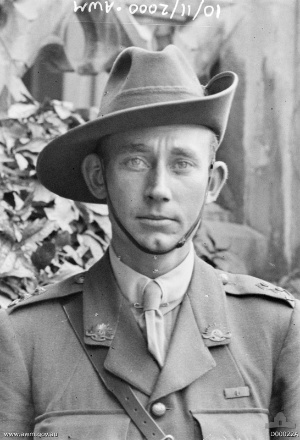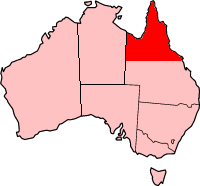51st Battalion, Far North Queensland Regiment facts for kids
Quick facts for kids 51st Battalion, Far North Queensland Regiment |
|
|---|---|

Cap badge of the Far North Queensland Regiment
|
|
| Active | 1916–1919 1921–1930 1936–1943 1950–1960 1965–1976 1985–present |
| Country | |
| Branch | Army |
| Role | Regional force surveillance |
| Size | One battalion |
| Part of | Regional Force Surveillance Group |
| Garrison/HQ | Cairns |
| Nickname(s) | The Eyes and Ears of the North |
| Motto(s) | Ducit Amor Patriae (love of country Leads Me) (Latin) |
| March | Quick – The Far North Queensland Regiment (Band); The Black Kookaburra (Pipes and Drums) Slow – Soldiers of the North |
| Commanders | |
| Honorary Colonel | Colonel K. Ryan |
| Insignia | |
| Unit colour patch |  |
| Abbreviation | 51 FNQR |
The 51st Battalion, Far North Queensland Regiment (51 FNQR) is a special unit in the Australian Army. It's based in Cairns and helps keep Australia safe. Their main job is to watch and gather information, especially near the border with Papua New Guinea in the Torres Strait and around Cape York.
These soldiers also help collect important information about the land. They work with local communities and help out during natural disasters. Soldiers in this unit learn many different skills. These include using weapons, surviving in the wild, sniping, first aid, driving, and handling small boats. They are known as "The Eyes and Ears of the North."
The 51 FNQR is the only battalion of the Far North Queensland Regiment. Its history goes way back to a unit that fought in World War I.
History of the 51st Battalion
World War I Service
The 51st Battalion first started in Egypt in early 1916. This was during World War I, after the Gallipoli campaign. The unit was formed by combining experienced soldiers with new recruits from Australia. Many of the first soldiers came from Western Australia. Some had already fought in Turkey.
The battalion, led by Lieutenant Colonel Arthur Murray Ross, went to France in June 1916. They soon joined the fighting at the Battle of Mouquet Farm. In just three weeks, they lost 650 soldiers who were either killed or wounded.
After this, they moved to Belgium. They fought in battles like Messines and Battle of Polygon Wood in 1917. In early 1918, they helped stop a big German attack. On ANZAC Day 1918, the battalion fought bravely at Villers-Bretonneux in France. They had 389 casualties in two days.
The 51st Battalion then took part in the final big Allied attack of the war. This was between August and September 1918. The unit was then taken out of the front lines because they had lost so many soldiers. The war ended on 11 November 1918, while they were training.
After the war, the 51st Battalion joined with other units. It was officially ended on 5 May 1919. During the war, 34 officers and 851 other soldiers were killed. Many more were wounded or captured. One soldier, Lieutenant Clifford Sadlier, won the highest award for bravery, the Victoria Cross (VC). He earned it for his actions at Villers-Bretonneux.
Between the World Wars
In 1921, Australia's part-time military was reorganized. The 51st Battalion was reformed in Western Australia. Over the next few years, it moved to different places like Tasmania and Sydney. In 1927, it was called the 51st Battalion, Field of Mars Regiment.
During the Great Depression, there wasn't much money for the military. The battalion had to join with other units twice. But in 1936, the 51st Battalion, Far North Queensland Regiment, was reformed in Cairns. This unit carried on the history of the original 51st Battalion.
World War II Service
When World War II began, the 51st Battalion was a part-time unit. Many soldiers joined the full-time army to fight overseas. So, the battalion's numbers went down. But in 1940, a national service plan brought more soldiers into the unit. They trained near Bowen.
In 1941, after Japan entered the war, the battalion was put on full-time duty. Their job was to defend the area around Port Douglas and Gordonvale. They later moved to Townsville and then Cairns.
In 1943, Australia needed more workers for its economy. So, many military units were combined or ended. The 51st Battalion joined with the 31st Battalion on 12 April 1943. This new unit was called the 31st/51st Battalion.
The 31st/51st Battalion went to New Guinea and later to the Solomon Islands. They fought their toughest battles on Bougainville, at Tsimba Ridge and Porton Plantation. The battalion was finally ended on 4 July 1946. During the war, 61 soldiers were killed, and 168 were wounded.
After World War II
The 51st Battalion, FNQR, was started again in 1950. In 1960, the army reorganized, and the regiment joined with other units. It became part of the 2nd Battalion, Royal Queensland Regiment. This lasted for five years.
In 1965, the unit was split again. The 51st became the 51st Battalion, Royal Queensland Regiment. Later, in 1976, it became a smaller unit called the 51st Independent Rifle Company.
The Regional Force Surveillance Unit (RFSU) Role
In the late 1970s, the Australian government wanted more military presence in northern Australia. This was to give early warning if anyone tried to enter Australian territory. So, three special units called Regional Force Surveillance Units (RFSUs) were created.
The first two were in Western Australia and the Northern Territory. To cover northern Queensland, it was decided to reform the 51st Battalion. In 1985, the 51st Independent Rifle Company became the 51st Battalion, Far North Queensland Regiment, once again.
Today, the 51st Battalion, FNQR, works as an RFSU. Their job is to patrol and watch the land and coastal areas in northern Australia. They cover a huge area of about 640,000 square kilometers. This includes Cape York and the Torres Strait.
Since 2010, the 51 FNQR has been part of the 6th Brigade. Most of its soldiers are reservists, who are part-time soldiers. Many of the unit's members are Indigenous Australians. In 2018, all three RFSUs joined together under a new group called the Regional Force Surveillance Group.
Battles and Honors
The 51st Battalion has a proud history of fighting in many important battles. These include:
- South Africa 1899–1902
- World War I: They fought on the Western Front in France and Flanders from 1916–1918. Key battles included Somme, Pozières, Bullecourt, Messines 1917, Polygon Wood, Passchendaele, and Villers-Bretonneux.
- World War II: The 31st/51st Battalion fought in the Liberation of Australian New Guinea and the Solomon Islands. Important battles were Tsimba Ridge and Bonis–Porton.
Commanding Officers
Here are some of the officers who led the 51st Battalion during the World Wars:
- World War I:
- Lieutenant Colonel Arthur Ross
- Lieutenant Colonel John Ridley
- Lieutenant Colonel Robert Christie
- World War II:
- Lieutenant Colonel Hubert Harris
- Lieutenant Colonel Oscar Issachsen
- Lieutenant Colonel Phillip Cardale
- Lieutenant Colonel Geoffrey Brock
See also
- Northern Command (Australia)





